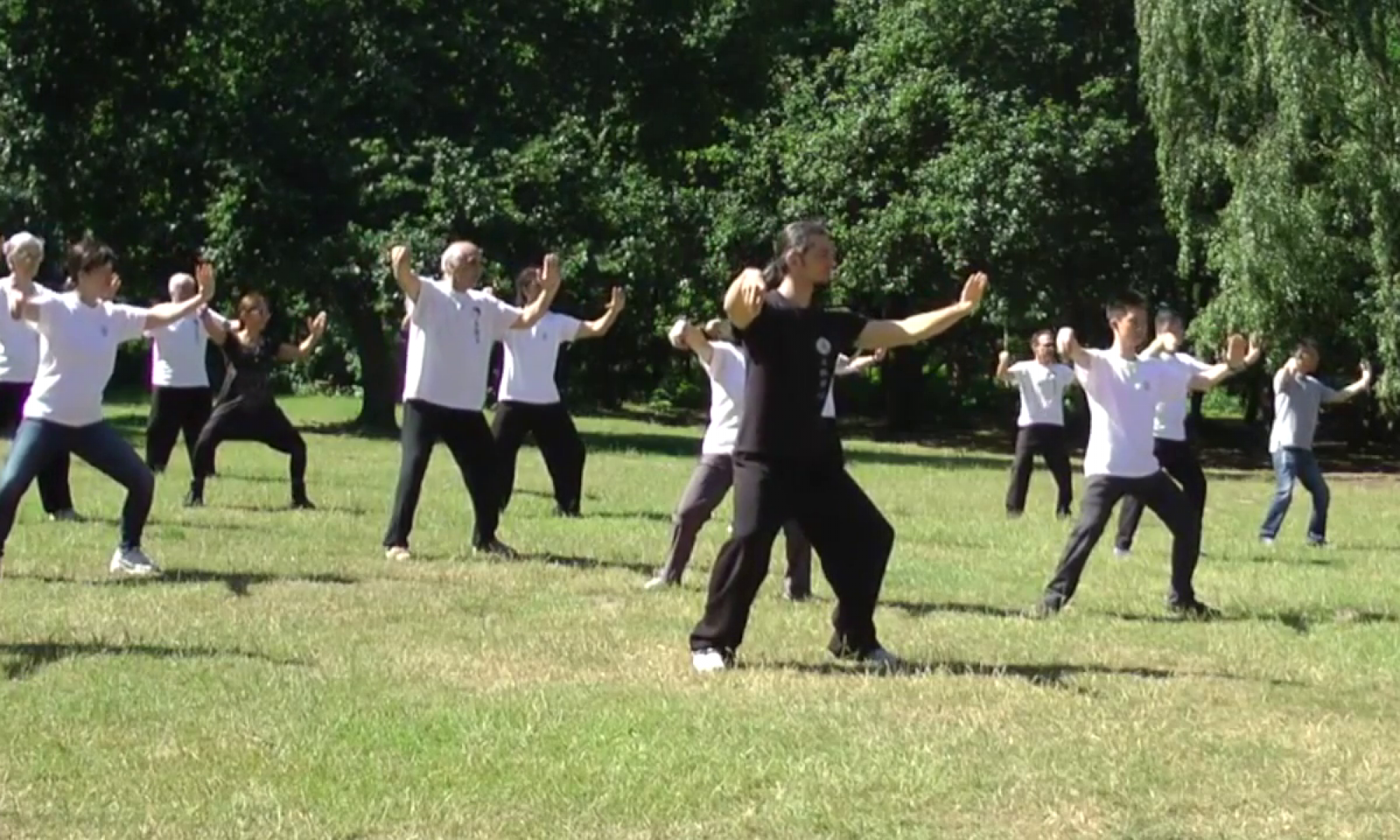lǎn què wěi 揽雀尾 grasping the bird's tail
三 攬雀尾(一)
3. GRASP THE SPARROW’S TAIL (part 1)
左脚跟落實,zuǒ jiǎo gēn luò shí Your left foot lowers fully,
脚尖徐轉向西,jiǎo jiān xú zhuǎn xiàng xī turned so the toes point to the west, {slowly / gently}
成為丁字步。(參看丁字步圖)chéng wéi dīng zì bù (cān kàn dīng zì bù tú)
making a T stance (as explained above), {refer to t-step picture}
右手隨腰轉向西,yòu shǒu suí yāo zhuǎn xiàng xī while your right hand, going along with the turning of your waist, goes to the west,
緩向上伸,huǎn xiàng shàng shēn slowly extending upward beyond your left hand,
超出左手;成立掌,(參看立掌圖)chāo chū zuǒ shǒu chéng lì zhǎng (cān kàn lì zhǎng tú)
making an upright palm (as explained above), {refer to upright palm picture}
與頭頂成直線。yǔ tóu dǐng chéng zhí xiàn at headtop level. {along with crown of head straight}
同時左手攏向西,tóng shí zuǒ shǒu lǒng xiàng xī At the same time, your left hand gathers in toward the west,
亦成立掌,yì chéng lì zhǎng also making an upright palm,
斜向上指,xié xiàng shàng zhǐ fingers diagonally upward,
貼近於右手的腕部。tiē jìn yú yòu shǒu de wàn bù nearing your right wrist.
兩肘尖下垂。liǎng zhǒu jiān xià chuí Your elbows are hanging down
兩臂略成半圜形。liǎng bèi luè chéng bàn yuán xíng and your arms are rounded almost into semicircles.
當移轉時,dāng yí zhuǎn shí During the turning [of your waist],
左腿彎曲,zuǒ tuǐ wān qū your left leg bends,
全身坐於左腿。quán shēn zuò yú zuǒ tuǐ the weight shifts onto it, {whole body sits on left leg}
右脚提伸於前方,yòu jiǎo tí shēn yú qián fāng and your right foot lifts and extends forward
作虚步。zuò xū bù . making an empty stance.
眼看正西。yǎn kàn zhèng xī . Your eyes are looking directly to the west.

如圖三。rú tú sān See photo 3:
四 攬雀尾(二)
4. GRASP THE SPARROW’S TAIL (part 2)
右手略向下沉,yòu shǒu luè xiàng xià chén Your right hand slightly sinks,
掌向上仰,zhǎng xiàng shàng yǎng palm facing up,
指尖與鼻成直線。zhǐ jiān yǔ bí chéng zhí xiàn fingertips at nose level, {and in line with nose}
左手仍貼近於右手腕部。zuǒ shǒu réng tiē jìn yú yòu shǒu wàn bù and with your left hand staying near your right wrist,
兩臂同時縮囘,liǎng bèi tóng shí suō huí your arms are withdrawing together,
右肘尖略近於右脅。yòu zhǒu jiān luè jìn yú yòu xié right elbow slightly nearing your right ribs.
步法不動。bù fǎ bù dòng Your stance has not changed.
眼看右手心。yǎn kàn yòu shǒu xīn Your eyes are looking toward your right palm.

如圖四。rú tú sì See photo 4:
五 攬雀尾(三)
5. GRASP THE SPARROW’S TAIL (part 3)
身向前傾,shēn xiàng qián qīng Your torso inclines forward,
頭部略過右脚尖為止。tóu bù luè guò yòu jiǎo jiān wéi zhǐ your head going slightly beyond your right toes,
右臂略伸直。yòu bèi luè shēn zhí. while your right arm almost straightens,
左手仍貼近於右腕部。zuǒ shǒu réng tiē jìn yú yòu wàn bù your left hand staying near your right wrist,
右腿彎曲,yòu tuǐ wān qū and your right leg bends,
膝挺向前。xī tǐng xiàng qián the knee going forward,
全身坐於右腿,quán shēn zuò yú yòu tuǐ the weight shifting to your right leg, {whole body on right leg}
成弓步。(參看弓步圖)chéng gōng bù (cān kàn gōng bù tú) making a bow stance (as explained above), {refer to gong bu picture}
左腿伸直。zuǒ tuǐ shēn zhí left leg straightening.
眼看右手心。yǎn kàn yòu shǒu xīn Your eyes are looking toward your right palm.

如圖五。rú tú wǔ See photo 5:
六 攬雀尾(四)
6. GRASP THE SPARROW’S TAIL (part 4)
右臂向右平引。yòu bèi xiàng yòu píng yǐn Your right arm draws across to the right,
左手依前式隨之,zuǒ shǒu yī qián shì suí zhī your left hand going along with it as before,
旋轉成半圜形;xuán zhuǎn chéng bàn yuán xíng and arcs to make a semicircle,
身腰亦隨之轉動;shēn yāo yì suí zhī zhuǎn dòng your torso also turning along with it.
及至旋至終點,jí zhì xuán zhì zhōng diǎn Once the arc reaches its end,
右手心轉向西南,yòu shǒu xīn zhuǎn xiàng xī nán your right palm turns to face to the southwest,
左手仍貼近於右腕部。zuǒ shǒu réng tiē jìn yú yòu wàn bù your left hand staying near your right wrist.
腰略向後倚,yāo luè xiàng hòu yǐ Your waist has slightly shifted back,
重心移於左腿。zhòng xīn yí yú zuǒ tuǐ the weight shifted to your left leg, {centre of gravity changed to left leg}
右腿伸直,yòu tuǐ shēn zhí right leg straight,
脚尖上翹,jiǎo jiān shàng qiào toes lifted,
脚心與右手心為同一方向,jiǎo xīn yǔ yòu shǒu xīn wéi tóng yī fāng xiàng sole in the same direction as your right palm,
成虚步。chéng xū bù making an empty stance.
眼看西南。yǎn kàn xī nán Your eyes are looking to the southwest.

如圖六。rú tú liù


There is a continuous debate about what moves first; the hands/arms or the waist. Both sides of the argument point to the taiji classics as proof of their argument.
In part 4 above, both hands are mentioned first and then “your torso also turning along with it.” seem to imply that the movement is started at the arms?
Notice that the text says “Once the arc reaches its end, your right palm turns to face to the southwest,” However, Jin teaches that the the palm turn finishes at the same time as the end of the arc of the waist.
this can be checked against a partner: as the palm (the index finger of the Right hand) reaches your partners shoulder, then the palm turns while the waist continues to turn, both finishing together. This is more effective against your partner than turning your waist and palm separately.
In section 4 (part 2) “Your right hand slightly sinks”opposite shoulder (where you want to move them to!)
Both arms sink.
If you were being pushed, your opponent would be pushing your right wrist and right elbow.
Drop your elbow, keeping it in line with your shoulder. This draws your opponent in.
Then roll your palms (right palm up, left palm down) this disrupts the opponents push and finishes the neutralisation.
Then push forward. The amount you turn your waist (to the left) depends upon the amount of force applied by your opponent. Then turn your waist to the right pushing against your opponent (shoulder / arm / body) with the strength in your body (not your arms) focus on your opponents
When being pushed try to lower and push back the hips only lowering the elbows slightly. Start turning the palms, then bending the front knee, then lowering the front toes, then pushing forward from the back leg and extending the arms (all in a continuous motion). Intention on the forward left diagonal before turning the waist to the right.
Keep the dang open throughout.
At the end of the move, when sitting back into xu bu and centering the waist, keep the hands out and the R toes down. Then when turning further to the R, the toes raise and immediately turn to the R, the body turns towards the arms before they push out to the diagonal shifting the weight to the R foot bending the R knee and straighten the L leg.